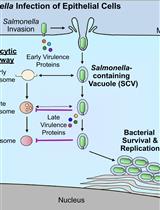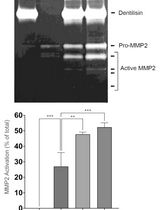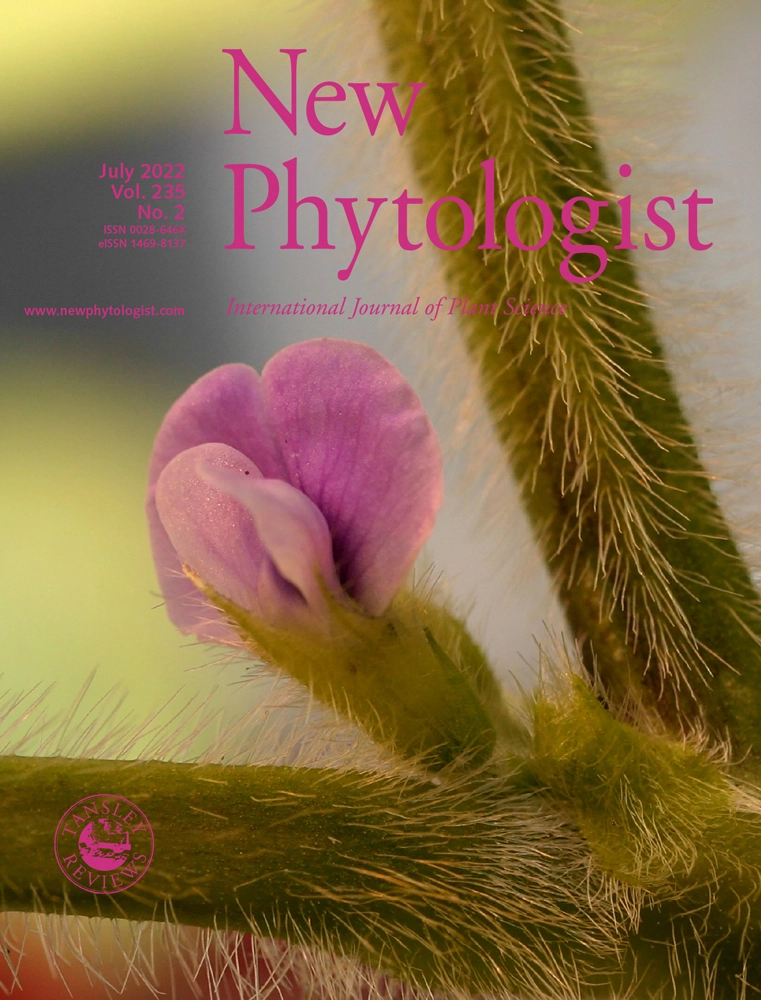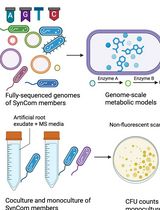- EN - English
- CN - 中文
A β-glucuronidase (GUS) Based Bacterial Competition Assay to Assess Fine Differences in Fitness during Plant Infection
基于β-葡萄糖醛酸酶 (GUS) 的细菌竞争测定以评估植物感染期间适应性的细微差异
发布: 2022年07月05日第12卷第13期 DOI: 10.21769/BioProtoc.3776 浏览次数: 3018
评审: Samik BhattacharyaErwan GueguenArmel Gallet

相关实验方案

细菌病原体介导的宿主向溶酶体运输的抑制:基于荧光显微镜的DQ-Red BSA分析
Mădălina Mocăniță [...] Vanessa M. D'Costa
2024年03月05日 2678 阅读

通过制备连续聚丙烯酰胺凝胶电泳和凝胶酶谱分析法纯化来自梭状龋齿螺旋体的天然Dentilisin复合物及其功能分析
Pachiyappan Kamarajan [...] Yvonne L. Kapila
2024年04月05日 1848 阅读
Abstract
Competition assays are a simple phenotyping strategy that confront two bacterial strains to evaluate their relative fitness. Because they are more accurate than single-strain growth assays, competition assays can be used to highlight slight differences that would not otherwise be detectable. In the frame of host-pathogens interactions, they can be very useful to study the contribution of individual bacterial genes to bacterial fitness and lead to the identification of new adaptive traits. Here, we describe how to perform such competition assays by taking the example of the model phytopathogenic bacterium Xanthomonas campestris pv. campestris during infection of the mesophyll of its cauliflower host. This phenotypic assay is based on the use of a Competitive Index (CI) that compares the relative abundance of co-inoculated strains before and after inoculation. Since multiplication is a direct proxy for bacterial fitness, the evolution of the ratio between both strains in the mixed population is a direct way to assess differences in fitness in a given environment. In this protocol, we exploit the blue staining of GUS-expressing bacteria to count blue vs. white colonies on plates and estimate the competitiveness of the strains of interest in plant mesophyll.
Keywords: Competitive Index ( 竞争指数)Background
Over the years, topics of ecology and evolution have been increasingly important when studying host-microbe interactions. In addition to simply assessing the virulence of bacterial pathogens, matters of fitness and adaptation to the environment are now being addressed. Recently, large-scale high-throughput screening tools, such as RB-TnSeq (Randomly-Barcoded Transposon insertion site Sequencing), have been developed to efficiently identify the genetic determinants of bacterial fitness. RB-TnSeq relies on the co-inoculation of a library of mutagenized bacteria, all carrying a unique barcode, to simultaneously evaluate the contribution of each gene to bacterial survival and growth (Wetmore et al., 2015). Such studies result in the identification of genes putatively implicated in bacterial adaptation to the host that then need to be confirmed by reverse genetics using simpler fitness assays.
Early on, it was proposed that competition assays could be used as an answer to this need. Typically, such competition assays are performed by co-inoculating two strains in a 1:1 ratio into a given environment and following the evolution of this ratio over time. If one of the strains grows more than the other, it is considered as more fit (in this specific environment) than its counterpart. The main limiting factor is then to be able to count separately the two mixed populations. A quite straightforward solution here is to use discriminating markers, such as antibiotic resistance, to count the abundance of each strain after plating on selective medium. Differential antibiotic resistances have been widely used in co-inoculation assays (Macho et al., 2007 and 2010; Feng et al., 2012), but it is known that such resistances often carry a strong cost of fitness that could interfere in studies that involve fine fitness mechanisms. Also, they require plating the samples twice, once on each selective medium, which can introduce a bias in the evaluation of the strains relative frequencies. Fluorescent markers provide an alternative to antibiotics but require costly imaging equipment (Perrier et al., 2019). Here, we describe a visual blue/white screening using the enzymatic properties of the beta-glucuronidase (GUS) enzyme. The assay is then performed by co-inoculating a GUS-expressing strain in competition with a non-tagged strain: after plating on medium containing X-gluc (the substrate of the GUS enzyme), colonies of tagged bacteria will turn blue while the others will remain white. A similar Bio-protocol had been proposed before using LacZ as a marker in the Vibrio cholerae animal pathogen (Fu and Mekalanos, 2014). However, even though the concept is similar, we feel that a detailed protocol for plant inoculations is very much needed.
Here, we chose the bacterial phytopathogen Xanthomonas campestris pv. campestris (Xcc) as a model to illustrate this protocol. Xcc is particularly interesting because it has the specificity to infect multiple organs and tissues of its cauliflower host (Brassica oleracea pv. botrytis cv. Clovis). After entry through the hydathodes, Xcc spreads through the xylem sap-conducting vessels and colonizes the leaf mesophyll of its host, where it causes the typical symptoms of the Black rot disease (Vicente and Holub, 2013; An et al., 2019). We recently performed an RB-TnSeq screening on Xcc during cauliflower infection (Luneau et al., 2022), which ultimately led us to set up a competition assay. In this protocol, we describe how this competition assay can be performed in the plant leaf mesophyll. We take the example of the well-described hrpX (transcriptional activator of the Type III Secretion System), hrcV (Type III Secretion System component), and xopAC (Type III Effector) mutants that display contrasted fitness phenotypes when confronted with the Xcc 8004 wild-type strain in planta. This protocol provides a basis that can be adapted for other plant compartments, such as hydathodes or xylem, as well as in vitro studies. Availability of such protocol is particularly relevant given the number of plant pathogens that enter through and thrive in their host leaves.
Materials and Reagents
2-mL microcentrifuge tubes (Sarstedt, catalog number: 72.695.400)
5-mL tubes (Sarstedt, catalog number: 72.701)
Petri dishes 92 × 16 mm (Sarstedt, catalog number: 82.1473)
1-mL Blunt syringe (SOFT-JECT HSW, catalog number: 5010.200V0)
Sterile 4-mm diameter glass beads (Dutscher, catalog number: 068502)
Sterile 96-well V-bottom clear polystyrene microplates (Greiner Bio-One, catalog number: 651101)
Sterile pipette tips
Compost (Proveen, catalog number: 14926)
Cauliflower: Brassica oleracea var. botrytis cv. Clovis F1 (Vilmorin)
Note: Plants are grown under greenhouse conditions and used at 4 weeks after sowing. All inoculations were performed using the second true leaf (second leaf above the cotyledons). After inoculation, plants are kept in classical growth chamber conditions: 9 h light, 22°C, and 70% relative humidity.
Xanthomonas campestris pv. campestris (Xcc) strain 8004::GUS-GFP (WT hereafter; Cerutti et al., 2017) and variants: Xcc 8004::GUS*-GFP* (WT* hereafter, carrying the point mutations Y468A and Y66A inactivating the catalytic sites of the β-glucuronidase and GFP proteins respectively); Xcc 8004::GUS-GFP ΔhrpX; Xcc 8004::GUS-GFP ΔhrcV; Xcc 8004::GUS-GFP ΔxopAC
Note: With concerns to the cost of fitness related to the constitutive expression of the GUS-GFP cassette, we decided to create the non-functional version of the cassette for our reference strain. With this system, the two challenged strains carry and express the GUS-GFP cassette, but only one of them will actually appear as tagged. We thus remove the possibility of a fitness cost associated with the cassette while still being able to differentiate the two mixed strains.
Spectrophotometer cells (Standard Polystyrene Semi-micro Cuvettes, Sarstedt, catalog number: 67.742)
Sterile distilled water
Magnesium chloride (MgCl2) (Merck, catalog number: 105832)
Yeast extract (Sigma-Aldrich, catalog number: Y1625)
Casamino acids (BD, BD Biosciences, catalog number: 223050)
Potassium phosphate dibasic (K2HPO4) (Merck, catalog number: 105101)
Agar (BD, BD Biosciences, catalog number: 214010)
Magnesium sulfate heptahydrate (MgSO4·7H2O) (Merck, catalog number: 105886)
X-Gluc (5-Bromo-4-chloro-3-indoxyl-beta-D-glucuronic acid, cyclohexylammonium salt monohydrate) (BIOSYNTH, catalog number: B-7300)
DMF (N,N Dimethylformamide) (Sigma-Aldrich, catalog number: D4551)
Rifampicin (Euromedex, catalog number: 1059)
Methanol (VWR, catalog number: 20847.320)
Pimaricin (DSM, DEVLOCID Instant, catalog number: 00226)
MOKA medium (see Recipes)
1 mM MgCl2 solution (see Recipes)
X-gluc (see Recipes)
Rifampicin (see Recipes)
Pimaricin (see Recipes)
Equipment
6-mm diameter Hollow punch (Harris, Uni-Core, Electron Microscopy Sciences, catalog number: 69039-60)
Hand-held colony counter (Heathrow Scientific, catalog number: HS120000)
28°C bacteria incubator
Centrifuge (Eppendorf, model: 5415D)
Beads-assisted grinder (Retsch, catalog number: MM400)
Spectrophotometer (Amersham Biosciences, model: Ultrospec 2100 pro)
Sterile environment (bunsen burner or microbiology hood)
Multi-channel pipette (10–100 µL)
Mono-channel pipettes
Procedure
文章信息
版权信息
© 2022 The Authors; exclusive licensee Bio-protocol LLC.
如何引用
Luneau, J. S., Noël, L. D., Lauber, E. and Boulanger, A. (2022). A β-glucuronidase (GUS) Based Bacterial Competition Assay to Assess Fine Differences in Fitness during Plant Infection. Bio-protocol 12(13): e3776. DOI: 10.21769/BioProtoc.3776.
分类
微生物学 > 微生物-宿主相互作用 > 细菌
细胞生物学 > 细胞分离和培养 > 共培养
您对这篇实验方法有问题吗?
在此处发布您的问题,我们将邀请本文作者来回答。同时,我们会将您的问题发布到Bio-protocol Exchange,以便寻求社区成员的帮助。
提问指南
+ 问题描述
写下详细的问题描述,包括所有有助于他人回答您问题的信息(例如实验过程、条件和相关图像等)。
Share
Bluesky
X
Copy link










